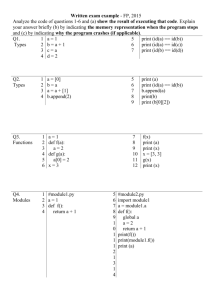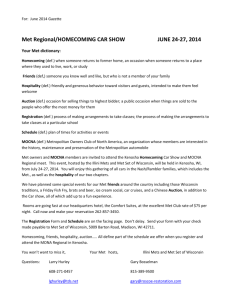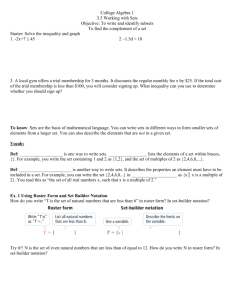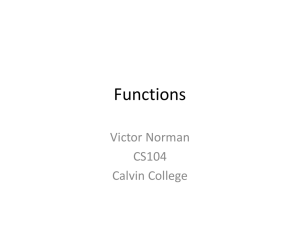Chapter 3
advertisement
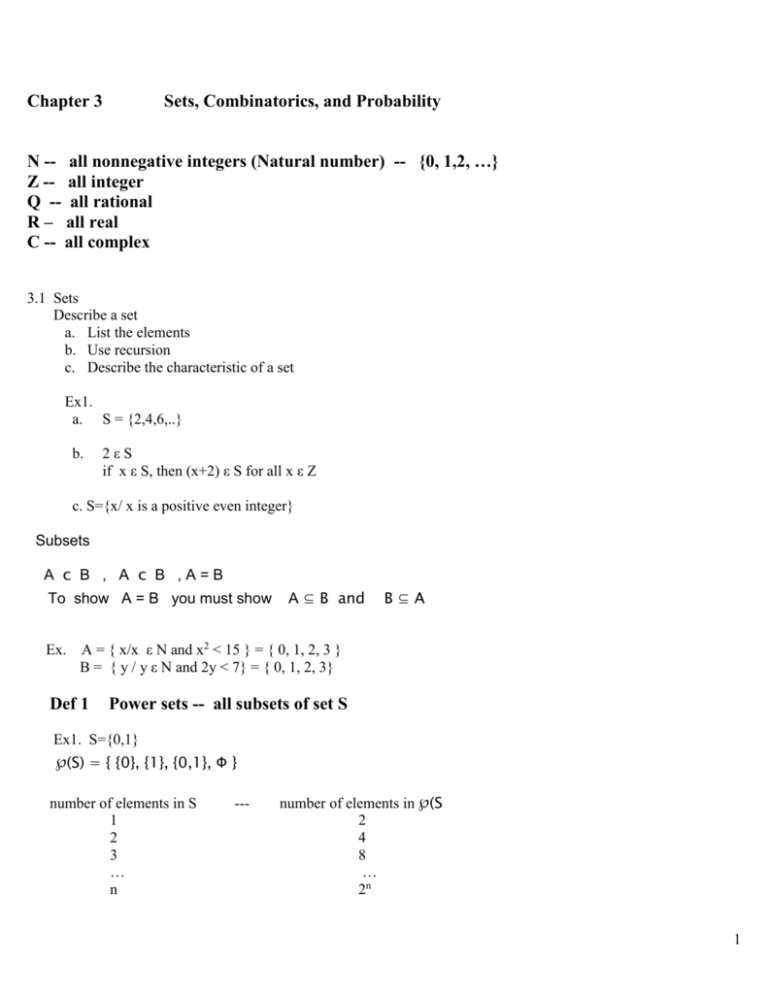
Chapter 3
Sets, Combinatorics, and Probability
Ν -- all nonnegative integers (Natural number) -- {0, 1,2, …}
Ζ -- all integer
Q -- all rational
R – all real
C -- all complex
3.1 Sets
Describe a set
a. List the elements
b. Use recursion
c. Describe the characteristic of a set
Ex1.
a. S = {2,4,6,..}
b.
2εS
if x ε S, then (x+2) ε S for all x ε Z
c. S={x/ x is a positive even integer}
Subsets
A с B , A с B ,A=B
To show A = B you must show
Ex.
A ⊆ B and
B⊆A
A = { x/x ε N and x2 < 15 } = { 0, 1, 2, 3 }
B = { y / y ε N and 2y < 7} = { 0, 1, 2, 3}
Def 1
Power sets -- all subsets of set S
Ex1. S={0,1}
℘(S) = { {0}, {1}, {0,1}, Ф }
number of elements in S
1
2
3
…
n
---
number of elements in ℘(S
2
4
8
…
2n
1
def 2. Binary operation (ordered pair)
˚ is a binary operation on a set S if for every ordered pair(x, y) of
elements of S , x ˚ y exists, is unique, and is a member of S.
examples --------
2
Operation of sets --- Union, Intersection, Venn diagram, …
examples ----
Def 3 Complement of a set -- for a set A ε ℘(S) , the complement of A , A’,
is {x / x ε S and x ∉ A}
examples --
Def 4 Cartesian Product
A с S and A с S --- The Cartesian Product (cross product ) of A x B :
A x B = {(x, y) / x ε A and y ε B}
Examples ---
Basic set identities --- page 173
….
[AU (B.∩ C)] ∩ ([A’U (B.∩ C )].∩ (B ∩C)’) = Ф
finite
infinite ----- (a) countable -- rational numbers, denumerable
(b) uncountable -- real numbers
Ν = { 0, 1, 2, 3, 4, …}
E = {0, n2, 4, 6 …}
Q+ = positive rational is denumerable
3
3.2 Counting
(a) Multiplication Principle If there are n1 possible outcomes for a first event and n2 possible outcomes for a second event, there
are n1 X n2 possible outcomes for the sequence of the two events.
examples --
(b) Addition Principle -if A and B are disjoint events with n1 and n2 possible outcomes, respectively,
then the total number of possible outcomes for event “A” and ‘B” is n1 + n2.
examples --
(c) Using the two principles together
examples –
3.3 Principle of Inclusion and Exclusion; Pigeonhole Principle
│AU B│ = │A│ + │B│ - │A ∩ B │
│AU B U C│ = {│A│ + │B│ + │C│} - │A ∩ B │ - │A ∩ C│- │B ∩ C │ + │A ∩ B ∩ C │
examples --- page 204~206 example 41 example 42
4
Pigeonhole Principle
--
if more than k items are placed into k bins, then at least one bin contains more than one item.
examples – 43 page 206
3.4 Permutations and Combinations
(a) Permutations -- an ordered arrangement of objects
examples --
(b) Combinations -- (order is not important)
examples --
5





